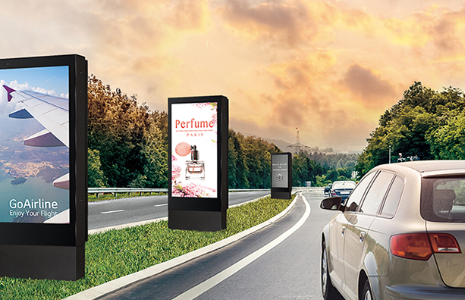Outdoor Digital Signage: Revolutionizing Outdoor Advertising and Information Display

In today’s fast-paced world, businesses and organizations are constantly seeking innovative ways to reach their target audience and engage them effectively. One of the most revolutionary solutions that has emerged in the realm of advertising and public communication is outdoor digital signage. From billboards to wayfinding displays, these dynamic screens are transforming how information is shared with the public, offering a more engaging, interactive, and modern approach to outdoor advertising.
What is Outdoor Digital Signage?
Outdoor digital signage refers to the use of digital displays such as LED screens, LCD monitors, and other electronic display technologies to deliver targeted content in outdoor environments. These displays can show videos, advertisements, live updates, and even interactive content, making them an invaluable tool for businesses, government institutions, and public areas like shopping malls, airports, and stadiums.
Unlike traditional static signage, outdoor digital signage allows content to be updated in real-time, offering versatility and ensuring that the message stays relevant. Whether it’s for advertising purposes, public announcements, or event notifications, outdoor digital signage display offer a level of customization and adaptability that static signage cannot match.
Key Benefits of Outdoor Digital Signage
- Enhanced Visibility and Impact
Outdoor digital signage attracts attention in a way that traditional billboards simply cannot. With vibrant, high-definition displays, businesses can capture the attention of passersby in busy streets, highways, and public areas. The dynamic content, whether it’s a video, animation, or live feed, ensures that the message stands out against the static background of traditional advertisements. - Real-Time Content Updates
One of the key advantages of outdoor digital signage is the ability to change content quickly and easily. This means that businesses can adapt their messaging in real time, promoting new products, services, or important information as it happens. For example, an outdoor digital signage display can be updated instantly to promote a flash sale or broadcast breaking news, making it much more relevant and timely than traditional printed signage. - Cost-Effective in the Long Run
While the initial investment in outdoor digital signage may seem higher compared to traditional signage, it’s important to consider the long-term benefits. Traditional billboards and posters require regular printing and maintenance, which can quickly become costly. In contrast, digital signage requires minimal ongoing expenses once installed, as content can be updated remotely with little additional cost. - Environmental Impact
Outdoor digital signage is often more eco-friendly compared to printed posters, which generate waste each time they are replaced. With digital displays, content can be changed without the need for printing new materials, reducing paper waste and the environmental footprint associated with traditional advertising methods. - Engagement and Interactivity
Many outdoor digital signage systems are interactive, allowing users to engage directly with the content displayed. For example, touch screens in malls or airports can help users find directions, locate stores, or access promotional content. This level of engagement not only makes the content more informative but also improves the overall customer experience.
Types of Outdoor Digital Signage Displays
- Outdoor LED Billboards
One of the most commonly seen forms of outdoor digital signage is the large LED billboard. These displays are typically found along highways, in city centers, or in sports stadiums. LED billboards can show bright, high-definition videos or images, making them ideal for advertising. - Digital Kiosks
These are smaller, often interactive displays located in areas like shopping centers, malls, airports, or train stations. Digital kiosks typically feature touch-screen technology, allowing users to interact with the content, access information, or make purchases. - Wayfinding Digital Displays
Wayfinding systems are an essential tool in large public spaces such as airports, universities, and hospitals. These digital displays guide people to their desired destinations, providing maps, directions, and updates in real-time. - Interactive Digital Signage
Interactive outdoor digital signage is becoming more popular, allowing users to engage directly with the display. For example, a touchscreen display may provide options for a customer to browse through available promotions or interact with live video feeds.
Challenges and Considerations for Outdoor Digital Signage
- Weather and Environmental Conditions
Outdoor digital signage displays are exposed to the elements, which can pose a challenge in harsh weather conditions. To address this, digital signage systems are designed with weather-resistant enclosures to protect against rain, extreme temperatures, and sunlight. Additionally, certain displays are equipped with features like anti-glare screens to ensure visibility even in direct sunlight. - Power and Connectivity
Running outdoor digital signage requires a reliable power source and network connectivity. In remote or off-grid locations, solar-powered options are becoming more popular, enabling these displays to function without the need for conventional power lines. Additionally, ensuring a stable internet connection is crucial for updating content and managing the signage remotely. - Maintenance and Longevity
While outdoor digital signage is built to be durable, regular maintenance is necessary to keep the displays functioning at their best. Routine cleaning, software updates, and hardware checks are essential to ensure that the signage operates smoothly, especially in high-traffic areas. - Content Management
To make the most of outdoor digital signage, it’s important to have a solid content management strategy. Whether it’s through centralized software or cloud-based systems, managing and scheduling content across multiple displays must be efficient and seamless to maximize the impact of the signage.
Read Also: Exploring the Future of Green Technology
The Future of Outdoor Digital Signage
The future of outdoor digital signage displays looks incredibly promising. With advancements in artificial intelligence, machine learning, and augmented reality, we can expect even more sophisticated content delivery methods. For instance, AI-powered systems can analyze viewer demographics, allowing for personalized advertising that targets specific audiences based on location, time of day, or other factors.
Additionally, the integration of mobile devices with digital signage will enable seamless interactions, such as scanning QR codes for discounts, engaging with social media feeds, or sharing promotions directly to smartphones.
Conclusion
As technology continues to evolve, outdoor digital signage is poised to become an integral part of how businesses and organizations communicate with the public. Whether used for advertising, wayfinding, or public announcements, the dynamic nature, real-time content updating, and ability to engage users make outdoor digital signage an essential tool in the modern world. By leveraging these digital displays, businesses can improve visibility, reduce costs, and enhance customer experience, ultimately setting themselves apart in today’s competitive landscape.





